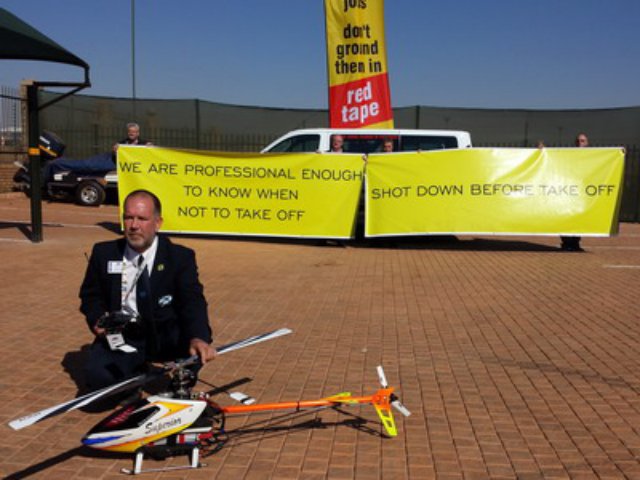The Commercial Unmanned Aircraft Association of South Africa (CUAASA) has warned that unmanned aerial vehicles (UAVs) that could deliver services and create jobs will be effectively grounded if the South African Civil Aviation Authority (SACAA) implements its new UAV regulations, impacting service delivery and job creation.
CUAASA made the comments at a workshop currently underway in Centurion to discuss the implementation of South Africa’s UAV regulations and the role industry can play in shaping these rules.
In South Africa, UAVs scan stockpiles daily on mines, investigate crop health and monitor erosion, replace expensive helicopter footage in the film industry, and monitor construction progress in projects like the Kusile and Medupi power stations, CUAASA pointed out. They are also beginning to play an important role in rural areas too, like in the aerial delivery of sputum samples from remote clinics to central processing labs and are also being used to curb rhino poaching and are being flown across the Kruger National Park and a number of private game farms to monitor and prevent illegal poaching.
“SACAA has given notice that – based on their interpretation of the legislation – they intend to subject drone license applicants to the same rigorous process as commercial freight and passenger airlines at the Air Services Licensing Council. This is untenable and unreasonable – akin to subjecting a model boat to a warship review,” CUAASA said.
“Moreover they will not recognise, or make a ‘grandfather clause’ allowance for pilots with years of experience who will simply be lumped together with novice applicants who have never flown before. That is not say that licensing must be a ‘free for all’. Technical standards and testing for RPAS pilots are essential. The immediate problem however is that no such standards exist and, as a consequence, no pilots will be able to apply to fly RPAS when the Amendment comes into affect on 1 July.
“Accordingly, CUAASA calls on [Transport] Minister Peters to instruct SACAA to: Exclude RPAS from Air Services Licensing Council certification; recognise existing, skilled RPAS pilots; and publish a framework for the technical standards and testing that RPAS pilots must meet in order to be licensed.”
CUAASA warned that failure to make these changes will not only ground RPAS for years to come – it will ground the delivery they can undertake and the jobs they will certainly create.
Nick Clelland from Resolve Communications said yesterday that his company has been contracted by CUAASA to change perceptions about UAVs. He said that governments do not like disruptive technology like UAVs as it doesn’t fit into existing regulations, which have to be redrafted and changed to accommodate them. Clelland said that government needs to work with industry to regulate the UAV industry much like it does to regulate disruptive technologies like the Uber taxi service.
“We are going to show government what we can do for you,” with UAVs, Clelland said, such as irrigation, crop fertilisation, asset protection, crowd control, construction monitoring, anti-poaching, pipeline monitoring, medical sample transport etc. In Japan, he said, UAVs have boosted agricultural output by 15% while in Australia they are delivering textbooks in the outback. He told workshop attendees that there is too much to lose regarding the use of UAVs in South Africa.
According to a Fortune magazine study, the impact of UAVs in the United States are predicted to have an impact of $82 billion between 2015 and 2025 and create 100 000 jobs. Clelland said it would be fantastic to replicate even a fraction of that in South Africa.
Economist Doctor Roelof Botha said that after doing an economic impact assessment using of CUAASA and its members, he concluded that their macro-economic impact would directly contribute R484 million to South Africa’s GDP; 2 022 direct jobs and tens of millions of rands in taxes. Botha said that the impact of CUAASA would amount to just over a billion rand, compared to just over R750 million from the 2014 edition of the Africa Aerospace and Defence exhibition.
Hennie Kieser, President of CUAASA, said that whether the industry likes it or not it has to comply with government regulations and has to stop reckless pilots from killing the industry. “SAACAA is guaranteed not ready for our applications. They don’t even have application forms for us,” Kieser said. As a result, on the 1 July, CUAASA plans to hand hundreds of UAV license applications to the Air Services Licensing Council to show they are not ready but “let’s work together to solve this.”
Until UAV pilots and commercial operators are licensed, they face a R50 000 fine if caught flying. At the moment there are several ways to fly UAVs. For recreational purposes, a pilot is required to join the South African Model Aircraft Association and fly from their airfields. A grey area is park flyers, who are allowed to fly electric powered UAVs under 2 kg from parks and fields, provided local authorities allow it. For commercial purposes, pilots have to follow the new Part 101 rules being implemented by SACAA.
Source: Defence Web

